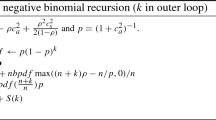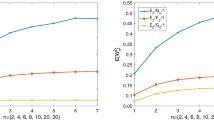Abstract
We study the tight upper bound of the transient mean waiting time in the classical GI/GI/1 queue over candidate interarrival-time distributions with finite support, given the first two moments of the interarrival time and the full service-time distribution. We formulate the problem as a non-convex nonlinear program. We derive the gradient of the transient mean waiting time and then show that a stationary point of the optimization can be characterized by a linear program. We develop and apply a stochastic variant of the Frank and Wolfe (Naval Res Logist Q 3:95–110, 1956) algorithm to find a stationary point for any given service-time distribution. We also establish necessary conditions and sufficient conditions for stationary points to be three-point distributions or special two-point distributions. We illustrate by applying simulation together with optimization to analyze several examples.


Similar content being viewed by others
References
Asmussen, S.: Applied Probability and Queues, 2nd edn. Springer, New York (2003)
Bertsekas, D.P.: Nonlinear Programming, 3rd edn. Athena Scientific, Belmont (2016)
Bertsimas, D., Tsitsiklis, J.N.: Introduction to Linear Optimization. Athena, Belmont (1997)
Birge, J.R., Dula, J.H.: Bounding separable recourse functions with limited distribution information. Ann. Oper. Res. 30(1), 277–298 (1991)
Chen, Y., Whitt, W.: Algorithms for the upper bound mean waiting time in the \(GI/GI/1\) queue. Queueing Syst. 94, 327–356 (2020)
Chen, Y., Whitt, W.: Extremal models for the \(GI/GI/K\) waiting-time tail-probability decay rate. Oper. Res. Lett. 48, 770–776 (2020)
Chen, Y., Whitt, W.: Extremal \(GI/GI/1\) queues given two moments: exploiting Tchebycheff systems. Queueing Syst. 97, 101–124 (2021)
Chen, Y., Whitt, W.: Extremal \(GI/GI/1\) queues given two moments: Three-point and two-point distributions. Working paper, Columbia University. http://www.columbia.edu/~ww2040/allpapers.html (2021b)
Chen, Y., Whitt, W.: Supplement to applying optimization to study extremal \(GI/GI/1\) transient mean waiting times. Working paper, Columbia University. http://www.columbia.edu/~ww2040/allpapers.html (2021c)
Chung, K.L.: A Course in Probability Theory, 3rd edn. Academic Press, New York (2001)
Daley, D.J., Kreinin, A.Y., Trengove, C.D.: Inequalities concerning the waiting-time in single-server queues: a survey. In: Bhat, U.N., Basawa, I.V. (eds.) Queueing and Related Models, pp. 177–223. Clarendon Press, Oxford (1992)
Denuit, M., Lefevre, C., Shaked, M.: The s-convex orders among real random variables with applications. Math. Inequal. Appl. 1(4), 585–613 (1998)
Feller, W.: An Introduction to Probability Theory and its Applications, 2nd edn. Wiley, New York (1971)
Frank, M., Wolfe, P.: Algorithm for quadratic programming. Naval Res Logist Q 3, 95–110 (1956)
Karlin, S., Studden, W.J.: Tchebycheff Systems; With Applications in Analysis and Statistics, vol. 137. Wiley, New York (1966)
Kingman, J.F.C.: Inequalities for the queue \(GI/G/1\). Biometrika 49(3/4), 315–324 (1962)
Lacoste-Julien, S.: Convergence rate of Frank–Wolfe for non-convex objectives. arXiv:1607.00345 (2016)
Lam, H., Mottet, C.: Simulating tail events with unspecified tail models. In: Proceedings of the 2015 Winter Simulation Conference 2015, 392–402 (2015)
Lam, H., Mottet, C.: Tail analysis without parametric models: a worst-case perspective. Oper. Res. 65(6), 1696–1711 (2017)
Reddi, S.J., Sra, S., Poczos, B., Smola, A.: Stochastic Frank–Wolfe methods for non-convex optimization. 2016\(54^{{\rm th}}\) Annual Allerton Conference on Communication, Control and Computing. IEEE, 1244–1251 (2016)
Rolski, T.: Order relations in the set of probability distribution functions and their applications in queueing theory. Dissertationes Mathematicae, Polish Academy of Sciences 132(1), 3–47 (1976)
Smith, J.: Generalized Chebychev inequalities: theory and application in decision analysis. Oper. Res. 43, 807–825 (1995)
Tijssen, G.A., Sierksma, G.: Balinski–Tucker simplex tableaus: dimensions, degeneracy degrees, and interior points of optimal faces. Math. Program. 81, 349–372 (1998)
Whitt, W.: On approximations for queues, I: Extremal distributions. AT&T Bell Lab. Tech. J. 63(1), 115–137 (1984)
Wolff, R.W., Wang, C.: Idle period approximations and bounds for the \(GI/G/1\) queue. Adv. Appl. Probab. 35(3), 773–792 (2003)
Acknowledgements
This research was supported by NSF CMMI 1634133.
Author information
Authors and Affiliations
Corresponding author
Additional information
Publisher's Note
Springer Nature remains neutral with regard to jurisdictional claims in published maps and institutional affiliations.
Rights and permissions
About this article
Cite this article
Chen, Y., Whitt, W. Applying optimization theory to study extremal GI/GI/1 transient mean waiting times. Queueing Syst 101, 197–220 (2022). https://doi.org/10.1007/s11134-021-09725-8
Received:
Revised:
Accepted:
Published:
Issue Date:
DOI: https://doi.org/10.1007/s11134-021-09725-8




